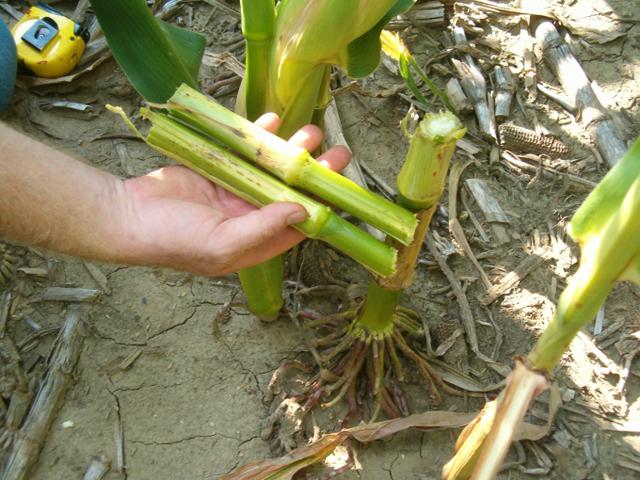Know Your Stalks
How Strong Are Your Corn Stalks? It's Time to Check.
ROCKVILLE, Md. (DTN) -- Ken Franklin knows better than to trust a windshield tour of his cornfields at this time of year.
From late August onward, you'll find the Taylorville, Illinois, farmer either flying a drone over his fields to spy on their inner secrets or tromping through fields the old-fashioned way. He'll use his findings to triage harvest and determine which fields go first and which can stand longer.
Between drought, summer windstorms, high disease pressure and a boom year for the corn rootworm, even the best-looking cornfields may be hiding stalk problems, which will make late-season scouting crucial.
"With all the growth we had this year, it feels like walking through a rainforest," Franklin told DTN of his Illinois scouting trips. "But that's how you can feel how flexible the stalks are."
To fully assess stalk strength, Franklin admits to roughing up his crop a bit. "Push and see how far they bend before snapping, pinch the bottom of the stalk and see if it has good integrity," he advised.
Between the drone images and his scouting, Franklin now has a good feel for which fields he'll have to tackle first -- ones with goosenecking from June windstorms and other fields that took the brunt of a mid-August squall that sent winds flying up to 60 to 70 mph through his fields.
"You always want late-summer rain, but you do cringe waiting to see what comes with it," Franklin said. "Our weakest stalks are definitely the ones bent over, and the goosenecked corn."
WHAT'S ON THE MENU THIS MONTH? STALKS
P[L1] D[0x0] M[300x250] OOP[F] ADUNIT[] T[]
September can be a tough month for corn stalks. With the corn plant laser-focused on finishing grainfill, it tends to throw self-care out the window.
"The sole goal of a corn plant's life right now is to fill that ear," explained Purdue University Extension corn agronomist Dan Quinn. "So, it will do everything under the sun -- even cannibalize itself -- to do that." Weakened stalks are prone to lodging, which can complicate harvest and hurt yields.
In Indiana, a couple factors might be contributing to stalk cannibalization, Quinn added. First, disease pressure was high this year, thanks to plentiful moisture and humidity in many fields. Leaf diseases such as gray leaf spot, Northern corn leaf blight, tar spot and Southern corn rust are not hard to find in many fields, Quinn noted.
"Any conditions, like disease, that cause that corn plant to lose photosynthetic leaf area, push the plant to remobilize a lot of carbohydrates, particularly from the lower part of the stalk," he said.
Second, many farmers in the Eastern Corn Belt saw ideal conditions when the plant's ear size was being determined, Quinn noted. Good kernel set and pollination has resulted in some sizeable ears this year.
"So, on top of corn already doing everything it can to fill those ears, some of those ears are little bigger than normal, so the corn plant is working even harder," Quinn said.
Another common late-season foe of stalk health are opportunistic stalk rot pathogens, which are often lurking in cornfields and love to move into hollowed-out stalks, Quinn added. Drought stress can also set plants up for certain stalk rot pathogens and weakened root systems that lead to lodging, as this Kansas State University guide to harvesting drought-stressed corn notes: https://eupdate.agronomy.ksu.edu/….
Finally, growers who saw high rootworm pressure this year might find that their corn plants have a pruned root system that causes the plant to tilt over or even lodge completely. See more on rootworm pressures this year and how to assess your risk here: https://www.dtnpf.com/….
THE PUSH AND PINCH TREATMENT
When assessing corn plants for stalk integrity, it doesn't pay to be gentle. Like Franklin, Quinn likes to walk perpendicularly through cornfields, shoving on stalks as he goes, to see if they bounce back, snap over, or droop pathetically.
The pinch test is also helpful -- lean over and give the bottom portion of the stalk a good squeeze. Healthy, strong stalks will be hard; compromised ones will be squishy.
"If the stalk has some give, pull up that plant, split it and see how it looks," Quinn said. Hollowed-out piths are visible, as are certain stalk rot symptoms. See more on common stalk rots from Purdue University here: https://www.extension.purdue.edu/….
While you're out there, make note of which hybrids fell victim to certain diseases, such as tar spot, and which ones handled the seasons' stresses best, Quinn added. "We're starting to see some pretty stark hybrid differences between diseases," he said. "Take notes."
And while you can't do anything to help diseased corn plants or weakened stalks, this late-season scouting is your last, best way to get the crop across the finish line, Franklin said. Prioritize those fields for harvest, as they are least likely to withstand autumn windstorms.
"We've got a nice crop out there, we've made it this far and we don't want to lose it now," he said. "It helps to know what your risks are."
Emily Unglesbee can be reached at Emily.unglesbee@dtn.com
Follow her on Twitter @Emily_Unglesbee
(c) Copyright 2021 DTN, LLC. All rights reserved.






